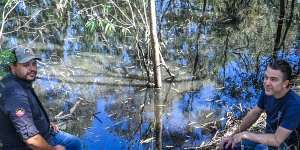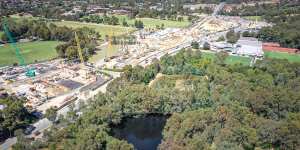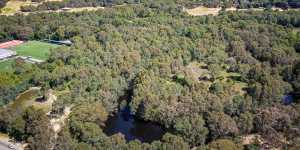But apart from a meagre pool of brown-green sludge at the farthest point from the river,the site in the photo – taken in 2017 – appears bone dry,resembling an eel-shaped scar in the earth outlined by a canopy of thirst-craved vegetation.
Seven years later,Bolin Bolin – one of around a dozen remnant billabongs along a stretch of the Yarra that was once part of a huge system of wetlands – is full of water and life thanks to rehabilitation efforts.

Its banks now hold much more water,which is clean and curves gloriously away under the bush canopy in either direction. A river red gum,monumental and at least 200 years old,wears a shield-shaped scar where a portion of its bark has been removed.
Further into the woodland,within a flourishing stand of juvenile Melaleuca,now abundant wildlife stirs:a flurry of honeyeaters skip and scatter through the dense foliage,a kookaburra swoops onto an eucalypt,an anxious ring-tailed possum scutters high up another tree,and a black cormorant surfaces with a sharp gasp close to the opposite bank.
But it’s not all nature’s idyll. Along the verge of the billabong,immediately to the east,big graders,bulldozers,trucks and cranes clatter and hum constructing a tunnel entrance for the.
Their industrious drone combines with the grumble of the tightly packed traffic edging along the newly upgraded Bulleen Road towards the Eastern Freeway.

The ongoing rehabilitation of sites like Bolin Bolin is seeing ancient water systems,long endangered by livestock grazing and urban development,being gradually restored in locations surrounding Melbourne’s CBD.
In the lower and middle Yarra – or Birrarung,as it is known by the Wurundjeri Woi Wurrung and other First Peoples within the Kulin confederacy – a collaboration between the Wurundjeri Narrap ranger team,Melbourne Water,other state water and parks managers and researchers is leading the way.
Wurundjeri Woi-wurrung man Mark Gardiner,34,started training as a ranger in 2018,shortly after the rehabilitation of Bolin Bolin commenced. He described the project as being about healing Country.

“It creates opportunity for community. Having managerial input is a big thing”:Wurundjeri Woi Wurrung man Mark Gardiner.Justin McManus
“We will never get it back to what it was because it was pristine. But it’s about endeavouring to get it there,” he said.
“The researchers found traces of myrtle beech,which is a rainforest tree. That tells us this place used to have pockets of rainforest to it. So,maybe we can try to get myrtle beech re-established in here too.”
Gardiner said the collaborative project provided the opportunity for the Wurundjeri to realise their aspirations for practical self-determination:“It creates opportunity for community. Having managerial input is a big thing.”
Due to large dams in the upper Yarra,the river has lost around a third of its true flow,according to Melbourne Water’s Sarah Gaskill,who has worked closely on the Birrarung billabongs project as the organisation’s water resources and compliance lead.
“The flows have changed and we’re trying to turn that around. We want a long-term fix,” Gaskill said.
Around five years ago,Melbourne Water partnered with University of Melbourne ecologist Dr Joe Greet,who was tasked with monitoring the effect of environmental water flows into billabongs in the middle and lower Yarra.
Greet said he has seen water flows grow from the original pumping efforts to the construction of permanent works like the system of inlet channels and culverts in Bolin Bolin that feed flood overflow from the Birrarung-Yarra into the site.
Other nearby billabongs and wetlands in the 1400 hectares of Yarra Valley Parklands – which runs from Warrandyte to Ivanhoe East – include those known as Montpelier,Horseshoe,Willsmere,Burke Road,Annulus,and the Banyule Flats.

Gardiner and Dr Joe Greet at Bolin Bolin Billabong.Justin McManus
Along with Bolin Bolin,they are all remnants of an immense eco-cultural system of wetlands and waterways resembling Kakadu in the Northern Territory,said Greet.
“Within the lower Yarra between Eltham and Kew there are now probably a dozen or so critically important sites,” Greet said. “And we’ve already lost too many.”
Rapid and steady degradation has occurred since the arrival of Europeans. The impacts of colonisation coupled with urban development and major projects like the North East Link – which Greet said could have an effect on groundwater flows over the long term – the landscape has become generally unrecognisable.

A tunnel entrance for Victoria’s $26 billion North East Link is under construction near the billabong.Justin McManus
Today,introduced species like foxes,carp,feral cats and deer – which began to wallow in Bolin Bolin during the quiet years of the COVID restrictions in Melbourne – continue to harm the complex ecosystems.
“There’s no shortage of animals posing a threat,” said Greet,whose research on the management of riverine wetlands was recently recognised with the 2024 Australian Academy of Science Aboriginal and Torres Strait Islander Scientist Award.
Gardiner said there is an urgent need to to control noxious weeds like spear thistles on the northern perimeter of Bolin Bolin.
“The native flora responds better to fire than the introduced species. We can really exhaust their seed bank with the use of fire,and with flooding as well,” he said.
“It’s a long process,but that’s our aim. Not just to slap a Band-Aid on it,to get things back to the way they were takes time.”
Gardiner said the permanent works had resulted in “regular and longer-duration of flooding”,sometimes lasting up to eight months. “The longer presence of water promotes healthy and lush native wetland plants,suppresses weeds,and improves the condition and reproductive output of the river red gums,” he said.
Greet said that while the extra water was beneficial,it was crucial for the system to dry out too.
“It’s actually about the wetting and the drying. The wetting and drying fuels the billabong ecology. The red gums are in better health since it got wetter,but they tend to flower in response to drying and the nectar is an important resource for the possums,bats and insects,” he said.
“The drying mud also provides the right conditions for the giant red gums to drop their seeds. And it also cues the migration of species.”

The billabong lies around 13 kilometres north-east of Melbourne CBD.Justin McManus
At about 300 years old,Bolin Bolin is considered a young billabong that formed after the main river channel naturally re-routed,said Greet. Sediment core samples taken from the site show the introduction of charcoal from Wurundjeri cultural burns in the area.
“These ecosystems were so productive that in places like Bolin Bolin you would see gatherings of up to 300-500 people coming together,often around this time of year in early March when the billabong was receding,for a huge eel feast,” Greet said.
In 2017,the tangible cultural value of the landscape and its spiritual significance to the Kulin nation was recognised in the,which recognises the river as a single,living entity.
“The concept of the Birrarung is more than just the main river,” Gardiner explained. “It’s the lifeblood of Country.”
Get the day’s breaking news,entertainment ideas and a long read to enjoy.